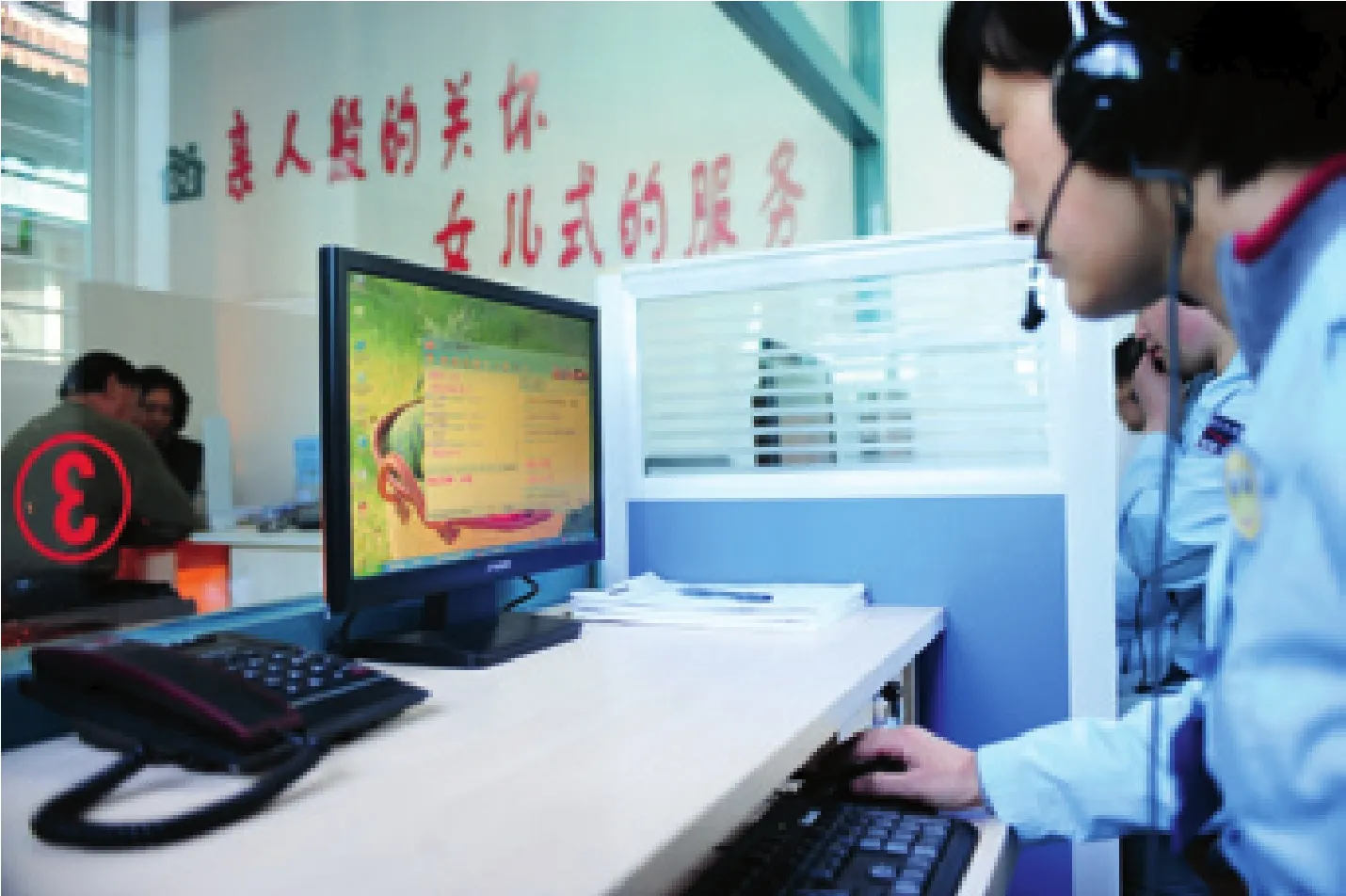Smart Disease Management
2012-10-16CuttingedgetechnologyhasbeenusedtomanageincreasinglyprevalentchronicdiseasesinChinaByWangHairong
Cutting-edge technology has been used to manage increasingly prevalent chronic diseases in China By Wang Hairong
Smart Disease Management
Cutting-edge technology has been used to manage increasingly prevalent chronic diseases in China By Wang Hairong
Already in her 80s, Fang Wenqi is not a tech-savvy person, yet she is using the cutting-edge technology known as the Internet of Things to monitor her health.
Fang, a resident in Beijing’s Haidian District, suffers from hypertension and cardiovascular disease. Thanks to a “black box,” a remote monitoring device, she can have doctors check her blood pressure and pulse without leaving her home. The data are transmitted to doctors in a nearby community health center, and stored in her personal medical record.
Her family doctor in the community health center will analyze the data and if they are not within the normal range, the doctor will call her and give her suggestions on how to adjust medication and treatment. The doctor will also let her know if further medical examination is necessary.
“Previously, I had to go to hospital very often. Now it is very convenient,” Fang said.
A 75-year-old diabetes patient surnamed Cao in Yuejiyuan community in Haidian also has a remote monitoring device at home. He uses the handheld device to monitor his blood sugar level.
The device is easy to operate. After connecting it to a cellphone customized for elderly people, Cao can select a time interval from four available choices in the phone’s menu: before a meal, two hours after a meal,after taking medication or anytime he feels uncomfortable. Collected blood sugar data can be transmitted instantly to a community health center for timely feedback.
Both Fang and Cao are bene fi ciaries of Haidian’s pilot program using the Internet of Things in the prevention and management of chronic diseases, the fi rst of its kind in the country.
A country with a higher incidence of chronic diseases, China does need more such programs.
Prevailing diseases
More than 260 million Chinese people suffer from chronic diseases, which lead to about 85 percent of all deaths in the country, according to data released by the Ministry of Health on July 9.
An earlier report released by the China Heart Congress even estimated that the number of people aged 40 and older with chronic diseases in the country would double or even triple by 2030.
Cardiovascular diseases, malignant tumors, diabetes and respiratory diseases are the major chronic diseases that affect the health of Chinese, said Kong Lingzhi, Deputy Director of the Department of Diseases Prevention and Control under the Ministry of Health.
Kong said that rapid industrialization,urbanization and an aging population mean the number of the country’s patients with chronic diseases has been rising continually and quickly. Chronic diseases have placed heavy pressure on the healthcare system, as such cases account for 70 percent of the total medical bills.
To address the problem, 15 central government departments including the Ministry of Health released the 2012-15 Blueprint on Chronic Disease Prevention and Control in May.
The blueprint, the fi rst national plan of its kind, sets the goal of extending the average life expectancy of the population by one year in the next three years.
To implement the blueprint, the Ministryof Health has taken a number of measures including monitoring risk factors and indicators of chronic diseases.
Establishing the monitoring and information management system for chronic diseases is one of the priorities on the agenda of the Ministry of Health, Kong said.
“When Internet of Things technology is applied to community-based medical services,patients with minor ailments, chronic diseases and common illnesses can be served by nearby community medical facilities, which can reduce unnecessary visits to large hospitals and save money for both patients and the government,” said Mao Yu, Deputy Director of Beijing Health Bureau.
In China, people tend to flock to large hospitals even for minor ailments. As a result,large hospitals are chronically packed, whereas community health centers are underused. In large hospitals, patients usually have to stand in long lines and wait for half a day for their turn to meet the doctor.
Lifestyle coaching
Chronic diseases are found to be related to unhealthy lifestyle risk factors such as smoking, obesity and diets high in salt and oil. To some extent these diseases can be prevented and controlled.
“Actually, these conditions are highly preventable and, if people can take simple steps like not smoking, limiting themselves to modest consumption of alcohol, having an active lifestyle and eating a balanced diet, they can keep healthy,” said Margaret Chan, Director General of the World Health Organization.

(Left) KEEPING FIT: Residents practice taiji in a residential compound in Ankang, north China’s Shanxi Province, May 27

HEALTH GUARDIAN: Staff at the Liaoshen Community Health Center in Shenyang,northeast China’s Liaoning Province, answer questions from patients via an online instant messaging system on April 11
Lifestyle risk factors are prevalent among Chinese population. A 2010 survey on residents above the age of 18 revealed that, more than 80.9 percent of households’ salt intake exceeded the recommended daily level of 5 grams, and 83.4 percent of households’ oil intake surpassed the recommended daily level of 25 grams.
The survey also showed that only 11.9 percent of Chinese people above 18 exercised often, about 30 percent were overweight, and approximately 10 percent were obese.
In addition, smoking also poses a serious hazard to Chinese people. The country has 350 million smokers and more than 700 million passive smokers. Every year, more than 1 million people die of smoking-related diseases.
“Victory in China’s battle against the rising threat of chronic diseases is in the hands of ordinary people,” Minister of Health Chen Zhu once said.
The 2012-15 Blueprint on Chronic Disease Prevention and Control sets the targets of reducing lifestyle risk factors such as smoking, lack of exercises, and obesity. It also includes plans to build more green areas and use the media to promote healthy lifestyles.
On August 21-22, the Chinese Center for Disease Control and Prevention hosted a conference to promote healthy lifestyles.Government officials attending the conference, stressed that an active lifestyle is the most cost-ef fi cient measure to prevent chronic diseases.
In Beijing, some new methods have also been used for lifestyle monitoring and coaching.
Liu Lanping, a Beijing resident close to 60, suffers from diabetes and high blood pressure. She has participated in a health self-management program administered by the Desheng Community Health Center in Xicheng District.
Liu carries a beeper-like portable energy monitoring device with her. Community doctors can receive her exercise and diet information via the gadget.
“When I saw doctors in large hospitals,although after prescribing medicine, they told me to exercise and watch my diet, yet they seldom clarify how to exercise and how much to eat,” Liu said. Now doctors in the community health center give Liu customized diet and exercise recipes every week.
Before subscribing to the health selfmanagement program, Liu took more than 10 types of drugs daily, and she often felt dizzy.After being in the program for three months when Liu combined medication with exercise and diet control, she became more energetic.
“The health self-management model lets patients of high blood pressure and diabetes learn to put their health in their own hands,”said Wang Hanliang, a professor at the National Medical Education Development Center in Beijing.
People used to go to hospital only after they became ill. Now with such technology as the Internet of Things, people can manage their health proactively and have many of their problems solved at the community level,said Liu Guoen, a professor at Guanghua School of Management at Peking University who specializes in health economics.
Managing chronic diseases at the community level cannot only lower total medical expenditures, but also improve patients’ quality of life. A study shows that the health selfmanagement program first implemented in Beijing’s Xicheng District annually saves an average of 720 yuan ($113.51) for each patients with high blood pressure and 480 yuan($75.67) each for those with diabetes.
